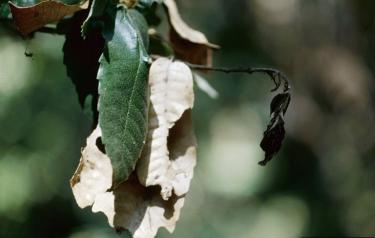When Pathogens Attack
Phytophthora ramorum, the pathogen that causes sudden oak death, can only be identified with a laboratory test. But it does have symptoms you can look for.
What Does It Do to my Trees?
Phytophthora ramorum is a fungus. It does particularly well in cool, wet environments but can also survive in drier climates. It is transported in part by infected plant material, which means you should be careful never to move firewood or other plant material from an affected area. It may also move in water and soil.
Sudden oak death can infect dozens of host plants, but usually only kills oaks and tanoaks. Even some oaks and tanoaks survive the disease.
Although a lab test is required for a definitive diagnosis, if the symptoms are appearing close to an area where infection is known to have reached, you should assume you're seeing sudden oak death.
On oaks and tanoaks, Phytophthora ramorum, symptoms may include:
- Bleeding or oozing. A black or reddish liquid appears to ooze or bleed from the tree, usually on the bottom six feet of the trunk. The ooze doesn't come from insect holes or cracks in the bark.
- Disease under the bark. Under the diseased area of bark, there are brownish patches outlined in black.
- Dead trees. Trees with sudden oak death die from the top down.
On other hosts, the pathogen can cause other symptoms, such as:
- Spots and blotches on leaves.
- Shoots die back.
- Dead young plants. Phytophthora ramorum foliar blight doesn't normally kill mature plants.
Hosts include camellia, rhododendron, and California bay laurel. The U.S. Department of Agriculture maintains a full list of plants that can be a host to Phytophthora ramorum.
Sudden oak death can't be identified based on symptoms alone. These symptoms could also come from many other diseases. If you think you might have it on your land, contact an expert. They can tell you how to submit a sample for testing.
If sudden oak death shows up in your woods, you aren't helpless. Read what you can do to help your trees.
How can I get more tips?
It’s simple! Enter your email below.

